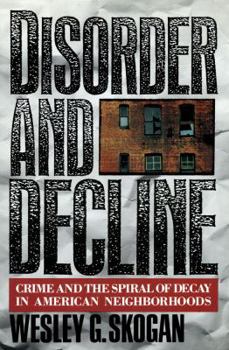Disorder and Decline: Crime and the Spiral of Decay in American Neighborhoods
Select Format
Select Condition 
Book Overview
The purpose of this book is to add a new concern to the list of issues contending for position on the nation's urban policy agenda. By highlighting the relationship between disorder and neighborhood... This description may be from another edition of this product.
Format:Hardcover
Language:English
ISBN:0029291518
ISBN13:9780029291511
Release Date:January 1990
Publisher:Free Press
Length:218 Pages
Weight:1.26 lbs.
Dimensions:1.0" x 6.4" x 9.6"
Customer Reviews
2 ratings
A good solid book, doing a much needed study
Published by Thriftbooks.com User , 17 years ago
For most of my life, one of the most hardened dogmas of liberal social science is that poverty causes crime, and that the only way to fight crime is to attack its "root causes" by spending ever more money on social programs aimed at reducing poverty. What the evidence actually shows is that poverty is correlated with crime. In other words, crime and poverty are often found together. The causual relationship between them, however, is not so obvious. At this point, it is fairly clear that poverty does not cause crime, at least not all by itself. We can say that with some certainty, because: (a) crime went way up in the 1960s, a time in which poverty was dropping and the economy was humming; and (b) crime went way down in the 1990s, a time in which the poverty rate was staying stagnant. But what about the connection, the other way? Does crime cause poverty? Are violent neghborhoods more likely to be poor? If you made an area less violent, would you also make it less poor? A common sense case can be made to answer "yes" to both questions. Skogan, as far as I known, is the ONLY social scientist to look into this question. I find it just astonishing that, with all of the trivial nonsense that has been studied to death, only one book has bothered to ask the question, does crime cause poverty? His answer, not surprisingly, is that crime and disorder (the two are related but not the same) tends to increase poverty, by throwing neigbhorhoods into a cycle of decline. Skogan basically provides social scientific verification of the obvious. If a bunch of gangbangers and drug addicts take over a neighborhood, the middle class people flee, which makes the neighborhood fall apart. We all know that, but, for those wanting scientific proof, Skogan provides it. This is an interesting illustration of how social science works. We start with the proven correlation between crime and poverty. If social science were honestly neutral, it would do studies to see which way the causality flows. But it does not. It just assums that poverty causes crime, because that fits its political agenda, of advocating more spending on anti-poverty programs. Other than Skogan, nobody bothers to look at the other alternative, that crime causes poverty. And again the motive is obvious. If you prove that Skogan is right, this supports a political agenda that social science hates: cracking down on crime, as a way to reduce poverty.
A Good Supplement to "Broken Windows"
Published by Thriftbooks.com User , 24 years ago
This book is a good compliment to "Fixing Broken Windows" by George Kelling and Catherine Coles. The latter book is essential reading for anyone interested in improving a declining neighborhood. This book, while useful in many respects, serves better as a supplement to some of the other work that's out there. The book certainly addresses an important subject and provides common sense, sometimes seemingly obvious, but often ignored directions on how to make our neighborhoods safer and more stable places to live.






